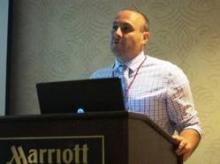NEW ORLEANS – Monitoring blood cultures for more than 24 hours may be unnecessary to rule out bacteremia in febrile, nontoxic infants, a new study suggests.
Among 393 blood cultures drawn at 17 institutions, 9.7% turned positive after 24 hours, compared with 3.8% after 36 hours and 1.8% after 48 hours, Dr. Eric Biondi said at the Pediatric Hospital Medicine 2013 meeting.
"Our data demonstrate that about 90% of blood cultures from febrile infants are going to turn positive by 24 hours when they are positive, and more than 95% are going to turn positive by 36 hours," said Dr. Biondi of the University of Rochester (N.Y.) Medical Center.
Using the Pediatric Research in Inpatient Settings (PRIS) Network, the investigators performed a retrospective chart review of 393 positive blood cultures drawn between January 2009 and January 2013 from infants less than 91 days old admitted for fever and treated as pathogenic. Their average age was 39 days and 51% were male.
Samples drawn from infants who had central lines, a surgical history, or were admitted to the ICU in less than 5 hours after the culture were excluded.
Overall Escherichia coli was the most common pathogen (41%), although there was significant variability of species between sites when compared with the reference site in Minnesota (P = .04), Dr. Biondi said. E. coli was the most common at 12 of the 17 sites, while group B streptococcus was the most common at 5.
The median time to positivity did not vary dramatically between species or sites, reaching a median of 13 hours for E. coli (range 12-15 hours) and 11 hours for group B strep (range 9-12 hours).
Based on the generally accepted premise that 2% of febrile infants will have bacteremia, the number needed to treat would be 515 infants for one blood culture to turn positive in more than 24 hours, Dr. Biondi said. That number increases to 1,315 infants after 36 hours and to 6,250 infants after 48 hours.
"You have to think about this in context," he remarked. "Even though about 10% of samples will turn positive after 24 hours, we’re talking about a group that includes only 2% of infants in the first place."
Although ruling out sepsis in febrile infants is one of the most common tasks hospitalists do, the inpatient observational period varies widely from 24 to as much as 72 hours. Dr. Biondi called for a prospective study to develop a national approach, but said that the current data are strong enough to guide clinicians now. The samples were all analyzed with an automated detection system and the PRIS Network is geographically diverse.
"If you’ve got a well-appearing kid staring at you and you’re just waiting for your blood culture, I’m hoping we can use these data to say, ‘We’re probably safe to send this one home,’ "he said.
Dr. Shawn Ralston, session comoderator and chief of the pediatrics section at Children’s Hospital at Dartmouth-Hitchcock Medical Center, Lebanon, N.H., said that she trained in the era of the 72-hour rule-out and described the self-funded, multicenter study as a tremendous undertaking that provides clinically important data hospitalists can use in the management of febrile infants.
"This contributes to patient-centered decision making with the number-needed-to-treat analysis, and I think it’s awesome," she said.
Dr. Biondi said in an interview that he and his colleagues are in the early stages of designing a prospective feasibility study at three sites that would provide more detailed information on positive, as well as negative, cultures and provide pilot data that could be used for a national study with the PRIS Network.
"We hope, in the end, that these data will lead to a cultural shift in the way we ‘rule out sepsis,’ which will allow us to treat kids with fewer doses of antibiotics and get them home with their families, where they belong," he said.
The meeting was sponsored by the Society of Hospital Medicine, the American Academy of Pediatrics, and the Academic Pediatric Association. Dr. Biondi and his coauthors reported having no financial disclosures.


